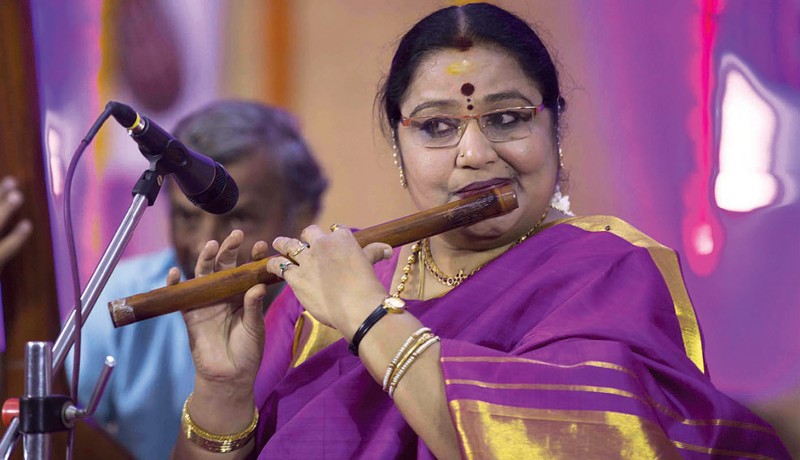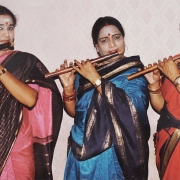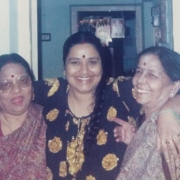
People

Flautist Mala Chandrasekhar shoulders a weighty mantle as torchbearer for her mother and her aunt, the Sikkil Sisters, writes Chitra Ramaswamy
You might call her an ‘accidental flautist’, which is ironic considering the celebrated exponent of the Sikkil bani (style) she is today. But the truth is, Mala Chandrasekhar, 54, daughter and niece of the famous flautists, the Sikkil Sisters, had to be delicately enticed into learning to play the instrument.
Her mother Sikkil Neela (Venkataraman) recounts an incident from when Mala was four years old. “My sister and I, along with our mother Sitalakshmi, stopped at bamboo flute maker Ananthanarayana Iyer’s after a concert. Mr Iyer gave her [Mala] a baby flute, saying she too should play the instrument like her mother and aunt. My mother felt this was providential. Perhaps this was the trigger that inspired me to initiate her on this journey. Mala still has this flute and it is one of her most cherished treasures.”
On the Sikkil style of flute playing, Mala says it is one where the audience literally ‘hears’ the lyrics of a composition. It originated with her maternal grandfather, Azhiyur Natesa Iyer, a mridangist of repute. But Mala’s mentors were her mother Neela and aunt Kunjumani, who together stormed a male bastion with their unique thuthukara (high vocal-oriented) style of flute rendition.
Mala speaks of her mother and her aunt, both Padma Shri awardees, with great affection and respect. She points out that the Sikkil Sisters were the first female instrumentalist duo in Carnatic music. As her now-deceased aunt was 11 years older than her mother, the latter learnt the instrument from her older sister. Ever since their debut in 1962, they performed together and were a sensation in Carnatic music for many decades, both in India and abroad.
Then, in 2010, Kunjumani passed away. And while Neela continues to perform, she restricts herself to radio performances. Though Kunjumani’s daughter Mythili is a flautist, she opted for a career as flute lecturer at Government Music College, Chennai. It was thus left to Mala to follow in the footsteps of the path-breaking musical sisters.
Looking back, Mala smiles when she recalls her indifference to playing the flute. As a youngster, she was a talented artist and loved to sketch and paint. But her mother and aunt had other plans and succeeded in changing the course of Mala’s destiny. How did they do it? They skilfully and subtly coaxed and cajoled her into practising the flute and performing in public while never pressurising her to do so.
As a result, Mala, who picked up the flute as a reluctant and playful five year-old, developed a passion for it, even if only in her mid-teens. Successful concert performances, musical ensembles in which she participated during her college years and, finally, marriage into a musical family, struck the right chords and there was no looking back.
Based in Chennai and married to Chandrasekhar, grandson of the legendary M S Subbulakshmi, Mala is a torchbearer of the Sikkil bani, but she has spiced it up with her individual style. The globe-trotting flautist and recipient of many prestigious awards speaks about her life-changing epiphany in college and her musical odyssey with the Sikkil Sisters.
IN HER OWN WORDS
Although music was all around me, I was drawn to the fascinating world of colours as a child. I simply loved drawing, sketching, painting, bead work, and anything that involved dabbling in colours. My parents would get me whatever art material I asked for and I would happily allow my imagination to run wild and create something new. This passion is an integral part of me. Whenever I have time away from music, I design jewellery and paint.
For a very long time, I would only relate to my aunt Kunjumani as my mother. Being the last child in a joint family, I was pampered and spent my childhood in a carefree manner. I was everybody’s pet and enjoyed all the adoration.
Mythili, Kunjumani amma’s daughter, was a committed musician who played the flute very well even as a young girl. I would constantly tease her about her musical abilities. On one such occasion, when I was eight or nine years old, she challenged me to prove my skills on the instrument instead of commenting on her rendition. My aunt, who witnessed this incident and was also aware of my indifferent attitude towards music, expressed doubts about my pursuing music and following in their footsteps. Although my mother had introduced me to the flute when I was five or six, I was very playful and not really interested in it. Besides, the ‘other world of art’ had totally captured my interest. With this incident, she became firm in her resolve to make me a flautist.
My mother’s desire and determination did not drive her to pressurise me. For me, mother as mother and mother as guru merged into a single entity. Though she is a disciplined person and rose to heights through perseverance, dedication and commitment, she did not force that learning on me. She would gently coax me to learn the instrument. There were no fixed practice, teaching or learning hours. These sessions happened as and when I was inclined. Sometimes, the learning would get tough and be a little too fast for my comprehension. I would sulk, get angry and finally abandon the lesson for that day.
Amma would allow my tantrum to run its course. If she was exasperated with my playing truant or my attitude, she didn’t show it. She went about the task of grooming me in such a subtle and loving way that even before I realised it, I was fast gaining proficiency in playing the instrument. She prepared me in such a way that I straightaway started performing at concerts; of course, with limited inputs and repertoire. Through my learning years up to the age of 15, I don’t recollect a single day when, without being asked to, I would pick up the flute to learn or play. While my mother would teach me one-on-one, my aunt would offer her inputs while discharging the household chores. I had the benefit of being guided by both of them, and all this in an informal, relaxed way. As I grew up, I realised the efforts my mother had put into my learning. What I am today, I owe entirely to her.
Amma was happy I had arrived. I got the opportunity to give a 15-minute live performance for TV in the Ilam Tendral programme in 1980. Before the programme, there was an audition for which my mother and aunt had trained and prepared me with total dedication. This was very well-received. Several other stalwarts in the field congratulated my mother and aunt for grooming their next-generation flautist. One of them even told Amma that they could perceive her indelible style in my rendition of a particular note. She was happy. More than that, she felt motivated and it boosted her confidence that I had finally arrived and would take her style of flute-playing forward. A window of opportunity opened up for me following this television broadcast.
Mother was open-minded. The real turning point in my musical journey came when I was in college, pursuing an undergraduate degree in botany from Stella Maris, Chennai. I was selected to be part of a veena-venu-violin (VVV) ensemble. Lalgudi Vijayalakshmi on the violin led the ensemble that had Jayanthi (now Jayanthi Kumaresh) on the veena. I was mesmerised by the melodic overtones and musical aspects of this venture, particularly by Viji’s rendering of certain phrases and nuances on the instrument. It kindled a spirit of healthy competition in me and I felt I had to measure up to them. My mother viewed this as a blessing for me. She was happy that it brought about a change of heart and made me passionate about music as I had never been before.
When I participated for the first time in a music competition in 1981 and won the first prize in the wind instruments category, I received the prize from M S Subbulakshmi, the queen of Carnatic music. It was a proud moment for me. But the most cherished moment came when I was asked to accompany the famous ‘Sikkil Sisters’ and we played as a trio. I was 17 years old then. The performance took place at Krishna Gana Sabha, one of Chennai’s premier concert halls. It was something I had never imagined.
Being married into a musical family enhanced my learning. Naturally, or by reflex, I imbibed and internalised the melody to which I was exposed during the VVV ensemble. I combined this with the consciously practised melody that I learnt from constantly observing MS to produce my own style. My belief is that unless we ourselves enjoy what we are singing or playing, we cannot transfer the feel to the audience or listeners. This is something I learnt from MS. In addition to rhythm, I have been able to infuse greater melody in hard-core classicism on the flute. This was a slight deviation from my mother’s and aunt’s rendition styles. For them, rhythm and concert presentation as traditionally followed were of paramount importance.
Mother gave me a free hand and believed in individual style. The music of my aunt and mother was pure, chaste, heavily classical, strictly adhering to tradition. While they were groomed in their traditional style, my mother wanted me to be different, individualistic. She instilled in me the sense of creating harmony while having a distinct style that would be entirely mine.
It has not been easy coming out of the shadows of my mother and aunt, and carving my own niche. As our concerts in the trio format drew huge audiences, both audiences and organisers stuck to the pattern. Age-related health issues forced my aunt to stop giving public performances and when she passed away in 2010, my mother and I continued playing as a duo till 2014. She too has become frail and does not have the stamina to give a three-hour concert, though she continues with her AIR programmes. I realised that though I had matured as a musician and flautist and could hold listeners spellbound on my own, it was a Herculean task to change the public’s mindset.
With passing years, I felt the need to be on my own because my creativity propelled me to realms my mother had not entered. Our thought processes also varied. The urge to explore, experiment and expand my repertoire of compositions and evolve as a musician overwhelmed me. I gave jugalbandi concerts, playing alongside renowned clarinet player A K C Natarajan and with some vocalists. In fact, because of the strict adherence to my mother’s and aunt’s classicism, I turned down film offers from Ilayaraja and A R Rahman in the earlier years of my concert performance. Music is a fathomless ocean and I wanted to delve into its depths. In fact, in certain measure, I willed myself to tear away from performing duets with my mother. The transition period and process were painful, no doubt, for both of us, but I felt this was an essential way forward.
My mother didn’t just teach me rhythm and chaste classicism in rendering the flute. Amma always laid emphasis on teamwork in a concert. She believed leadership involves carrying a concert through to its end, being adaptable to situations and sensitive to accompanying co-artists and audiences. She never took a concert lightly, no matter where it was being performed, whether in a temple, at a wedding, or in a prestigious hall. She imparted this sense to me as well.
Photos courtesy: Mala Chandrasekhar Featured in Harmony — Celebrate Age Magazine September 2017
you may also like to read
-
For the love of Sanskrit
During her 60s, if you had told Sushila A that she would be securing a doctorate in Sanskrit in the….
-
Style sensation
Meet Instagram star Moon Lin Cocking a snook at ageism, this nonagenarian Taiwanese woman is slaying street fashion like….
-
Beauty and her beast
Meet Instagram star Linda Rodin Most beauty and style influencers on Instagram hope to launch their beauty line someday…..
-
Cooking up a storm!
Meet Instagram star Shanthi Ramachandran In today’s web-fuelled world, you can now get recipes for your favourite dishes at….









